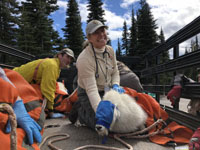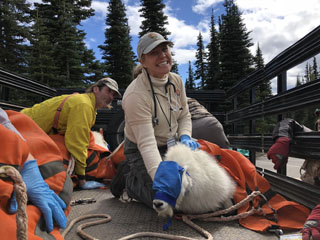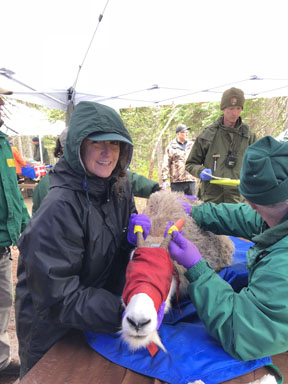
Dr. Jenny Powers

Photo courtesy Leading Edge Aviation
Her grin shows Dr. Jenny Powers' delight in assisting with the care of wild mountain goats captured at Olympic National Park.
For two weeks in September, a stretch of blacktop on Hurricane Ridge in Washington state's Olympic National Park looked like a MASH unit crossed with a petting zoo. Under temporary canopies, woolly mountain goats lay among IV fluid bags, oxygen tanks and other medical paraphernalia. Helicopter blades slapped the air nearby. The goats were fat from a summer of browsing. They wore blindfolds, their legs were hobbled, and their pointy horns were wrapped in rubber for their first-ever veterinary exam.
This processing station was a critical link in an effort to relocate hundreds of wild goats from the Olympic Peninsula on the Pacific Ocean to the North Cascades, mountains about 150 miles to the east. Veterinarians from three government agencies and a zoo veterinarian eagerly stepped away from their daily routines to oversee the care of the goats during the operation.
"I'd say this mountain goat project is probably going to be one of the highlights of my career," said Dr. Kristin Mansfield, a wildlife veterinarian at the Washington Department of Fish and Wildlife (WDFW), who co-led the veterinary effort with Dr. Jenny Powers, acting chief of the Wildlife Health Branch in the Biological Resources Division of the National Park Service (NPS).
Talking about the experience by phone with the VIN News Service a month later, Powers and Mansfield described it as exhausting and exhilarating, and something they'll never forget. Powers said she'd never seen a translocation of this magnitude during her career.
"It was just so well organized with a great team of people and pretty cool animals, and the overall project had some really good goals," said Mansfield, who still had tarps and tubs, clippers and surgical instruments piled in her office. "We're solving one problem in Olympic National Park and we're making things better in the Cascades."
The problem that needed solving was that a non-native species was on the peninsula. About a dozen mountain goats were imported to the area in the 1920s, before the park was established. They thrived. As their numbers grew to 1,000 by the 1980s, they began to negatively impact the park's alpine and subalpine vegetation. Mountain goats damage plants and destabilize soils through eating and trampling plants and wallowing. They also endangered park visitors.
Goats are attracted to salt, and there are few naturally occurring salt licks in the Olympics. When habituated to people, goats are attracted to hikers — more specifically, they are drawn to the salt in hikers' sweat, urine and food. This has led to dangerous encounters. In 2010, a mountain goat fatally gored a hiker.
In the North Cascades, where mountain goats are native, natural salt licks are abundant, and hikers are spread out over larger areas, so goats there are less likely to seek out hikers for salt. Plus, adding genetically different goats to the Cascades should help reverse years of overhunting, which is now more tightly controlled.
Before the operation this fall, the NPS estimated there were 725 goats on the Olympic Peninsula. More translocations are planned for coming years, with the goal of relocating between 325 and 375 goats, according to the final goat management plan. After capture operations cease, any goats remaining on the peninsula will be shot via a helicopter- and ground-based hunting operation.
Pink gums and rumen burps
Video courtesy Olympic National Park
The mountain goats were airlifted from the backcountry to a staging area near Olympic National Park headquarters.
Roundups in the Olympics this fall began with a helicopter team locating mountain goats and immobilizing them from the air with either a dart filled with an opioid or nets shot from a gun. The goats were secured in slings and flown, dangling from the helicopter, to the processing center near the park headquarters.
The helicopter team was provided by a private company that specializes in moving wildlife. The first veterinarian to make contact with the goats was Powers. She was stationed at the drop-off point about a quarter-mile from the processing center. The helicopter pilot skillfully lowered the just-captured goats into the back of a flatbed pickup for a short drive to the mini field hospital.
"We wanted to keep as few people around the moving blades as possible," Powers explained. During a bighorn-sheep relocation in 2007, a WDFW biologist was killed by a helicopter blade.
The first animals to come in were "very large billys," Powers said. "I thought, 'Wow, this is really going to happen.' "
When the goats touched down, Powers checked their gums, looking for pinkness, a sign of healthy oxygen levels. She was reassured by their burps, which give off a slightly sweet scent of fermenting forage and provides evidence they are digesting properly and not at risk for bloat. "I love that smell," she said.
Powers' core responsibility was developing drug protocols and loading darts for the helicopter team. She used an opioid to immobilize the goats and another drug to reverse the effect of the opioid, which was administered in the field immediately after drugged goats were captured by the helicopter team. She also oversaw the sedation of the goats before they were transferred to the processing area.
"I like to say drugs are your friends when it comes to wildlife," Powers said. "Most of the time, we are either a predator or a threat to any animal that we are going to be working with. So, if they are 100 percent aware of us, they are going to be under a lot of stress. I really like to have a sedative if for nothing else than to take away some of the fear."
Developing protocols for immobilizing and sedating wildlife requires a mix of approaches. Powers said she begins with The Handbook of Chemical Wildlife Immobilization. Because these drugs had been used for goats before, it was a fairly straightforward process. For species about which less is known, Powers will contact veterinary colleagues in the field and look to other literature.
"Our goal was to have a goat that was capable of holding its head up, taking care of its own physiology as far as thermoregulation, but sedate," she said. In other words, a goat that is calm but not so knocked out that its bodily processes don't function properly.
Silent, calm and stoic
Dr. Kristin Mansfield

Photo by Logan Weyand
Dr. Kristin Mansfield prepares a goat for a long journey across land and water to the North Cascades.
Once in the processing area, the goats were tended by Mansfield, who was joined by Washington State Veterinarian Dr. Brian Joseph and Dr. Allison Case, head veterinarian for Northwest Trek Wildlife Park, a public park near Seattle.
As an addition to the blindfolds and hobbles, Mansfield plugged the goats' ears to reduce stress on the animals by minimizing external stimuli, she said.
A first priority for the veterinarians was to take the goats' temperature. They anticipated that running from the helicopter and overall stress would raise the animals' body temperature. "Hyperthermia is probably the most common condition we deal with when we're capturing wildlife," Mansfield said.
The veterinarians examined the goats' eyes, cleaning off any dirt kicked up during capture. They checked for injuries and administered anti-inflammatory drugs "to help with aches and pains," Mansfield explained, "because there are going to be bumps and bruises during the capture."
The goats also received injections of a variety of drugs and supplements to boost their stressed immune systems, including an antibiotic to stave off infection; an anthelmintic to control parasites; and vitamin E and selenium to mitigate exertional myopathy, a condition in which the muscles become inflamed and break down. Mansfield said it's a relatively common result of wildlife captures. "We call it 'capture myopathy,' " she said.
Before they were done, the veterinarians and others on the team collected from each animal a sample of blood, fecal matter, nasal mucous, and skin from the ear for biopsy. They also took body measurements. Each goat was tagged on the ear, and every adult goat was fitted with a radio collar.
Throughout the process, the animals were quiet. Wild goats don’t bleat like their domesticated counterparts. “They are among the most calm and stoic species I’ve ever worked with,” Mansfield marveled.
Through it all, the veterinarians didn't approach the goats — as adorably snowy white as they are — like pets. "In general, they don't want to be touched, they don't want to be petted; they want to get away or they want to hurt you — one of the two," Powers said. "I try to think about that when I approach an animal."
For the next leg of their journey, the goats received subcutaneous fluids to keep them hydrated and, lastly, a long-acting tranquilizer for the long trip that would include hourly welfare checks and a ferry ride across Puget Sound.
Each goat was placed in its own crate. The crates were loaded into trucks that were refrigerated to 40 degrees or lower. "These guys are furrier than heck, and they're used to being up high where it's cool," Mansfield said. "So, we were really concerned about them getting too hot during that drive."
Mansfield said the results were good. "I'm aware of only two that have died out of the 98 that were released," Mansfield said, "which I think is pretty phenomenal given the type of operation."
Video courtesy Washington Department of Fish and Wildlife
The goats were released on national forest land in the North Cascades.
Overall, 115 goats were captured, according to Olympic National Park. In addition to the two that died during transport, two were euthanized due to suspected disease and another for a history of aggressive behavior, six died during capture and six orphaned kids were transferred to Northwest Trek.
That some goats will die from falls in steep terrain is an inherent risk of the operation, Mansfield said. "A lot of people think the dart goes into the animal, the animal goes down. But as veterinarians, we know that there is always an induction period and, at a minimum, that induction period is typically four minutes, and it can be up to 10 or 12," she said. "So that's a lot of time that the animal is trying to navigate the cliffs while succumbing to the effects of a drug."
Wrangling kids
The veterinarians were four in a diverse army of people making the operation go. The team included game wardens, park superintendents, helicopter crews, incident command personnel, biologists, veterinary technicians, veterinary students, drivers and handlers.
Although Case goes way back in the small world of wildlife veterinary medicine with Powers and Mansfield, she didn't know the majority of the field team that first day. "But that first goat comes in and you're working side-by-side. Instantly you are family," she said. A zoo veterinarian, Case was well-suited for the operation. Not only does she keep her clinical skills sharp working with captive wildlife at Northwest Trek, she has experience in the field. As a veterinary technician for the Colorado Division of Wildlife in the 1990s, she helped on projects involving large numbers of bighorn sheep and pronghorn antelope.
She had a special assignment on the mountain goat project. "They said, 'Allison, handle the kids!' And I was happy to handle the kids," she said. The job of looking after the youngest goats extended well beyond the mountain. During the planning stage, Northwest Trek, which is a sister zoo with Point Defiance Zoo & Aquarium in Tacoma, agreed to provide or help find homes for any orphaned kids.
"There is a reality in a translocation that sometimes nannies and kids are separated," Case explained. "This partnership was an incredible opportunity to provide homes for animals that might otherwise not be matched up with their moms and might perhaps struggle, and for us to be able to continue to exhibit mountain goats as ambassadors for wildlife ecosystems."
NW Trek kids

Photo by Katie Cotterill. Courtesy Northwest Trek
Orphaned kids were released at Northwest Trek Wildlife Park earlier this month.
On the first day, a single orphan that came in was sent to Northwest Trek. Case said the team felt protective toward the kid, concerned about him being by himself. "But he did great," she said. "And by the next day, he had two other buddies with him. All three of them immediately joined up together and then they were just like this one unit."
All told, six kids were transferred to the wildlife park. One male kid has since moved to Woodland Park Zoo in Seattle. The remaining five made their public debut in Northwest Trek's free-roaming area on Nov. 13.
Expanding role for wildlife DVMs
Having veterinarians on board for this sort of operation might seem to be a no-brainer. But according to Powers and Mansfield, that hasn't been standard operating procedure.
"Historically, wildlife agencies have not had their own veterinarians, and the biologists got used to doing everything on their own that normally would be considered veterinary work," Mansfield said.
Both Powers and Mansfield faced obstacles early in their plans to become wildlife veterinarians in the early 2000s. Powers was told she'd never find a job or get a real career. Mansfield said there were only a handful of veterinarians holding jobs in government agencies like she wanted. But conditions are shifting.
"Earlier wildlife agencies didn't have the money, resources, or information that would encourage them to hire veterinarians," Powers said. "Wildlife veterinary medicine is an emerging field and the wildlife community has come to embrace the skill sets we bring to a good team."
While wildlife organizations begin to accommodate veterinarians, the veterinarians make their own accommodations. Being a wildlife veterinarian means spending a lot less time with animals, and more time at your desk. It also means seeing your role differently.
"When I was in vet school, I very much felt that we were groomed to be the one who was leading, and that the veterinarian was supposed to be the one that was making the decisions," Powers said. "From my experience, when you're working on a wildlife team, everyone is bringing something to that team. And you have to really respect the fact that you're not always the one in charge, you're not always the final decision."
Sometimes, you're not even the one practicing medicine.
Mansfield said she teaches biologists and wildlife officers how to do things that traditionally are considered the practice of veterinary medicine because she rarely gets into the backcountry. "All you can do is make sure that the staff working under you can do a lot of these ‘vet' things,'" she said. "It's a little bit of putting your ego aside sometimes."
But the payoff on a personal and professional level is worth it, Mansfield and Powers said. Both feel like they've landed dream jobs. And that, they think, is good news for not only themselves, but for the veterinary profession.
"It's good to know that veterinarians play a strong and vital role in wildlife health as well as animal welfare aspects," Powers said. "We in the veterinary community should be proud of that."